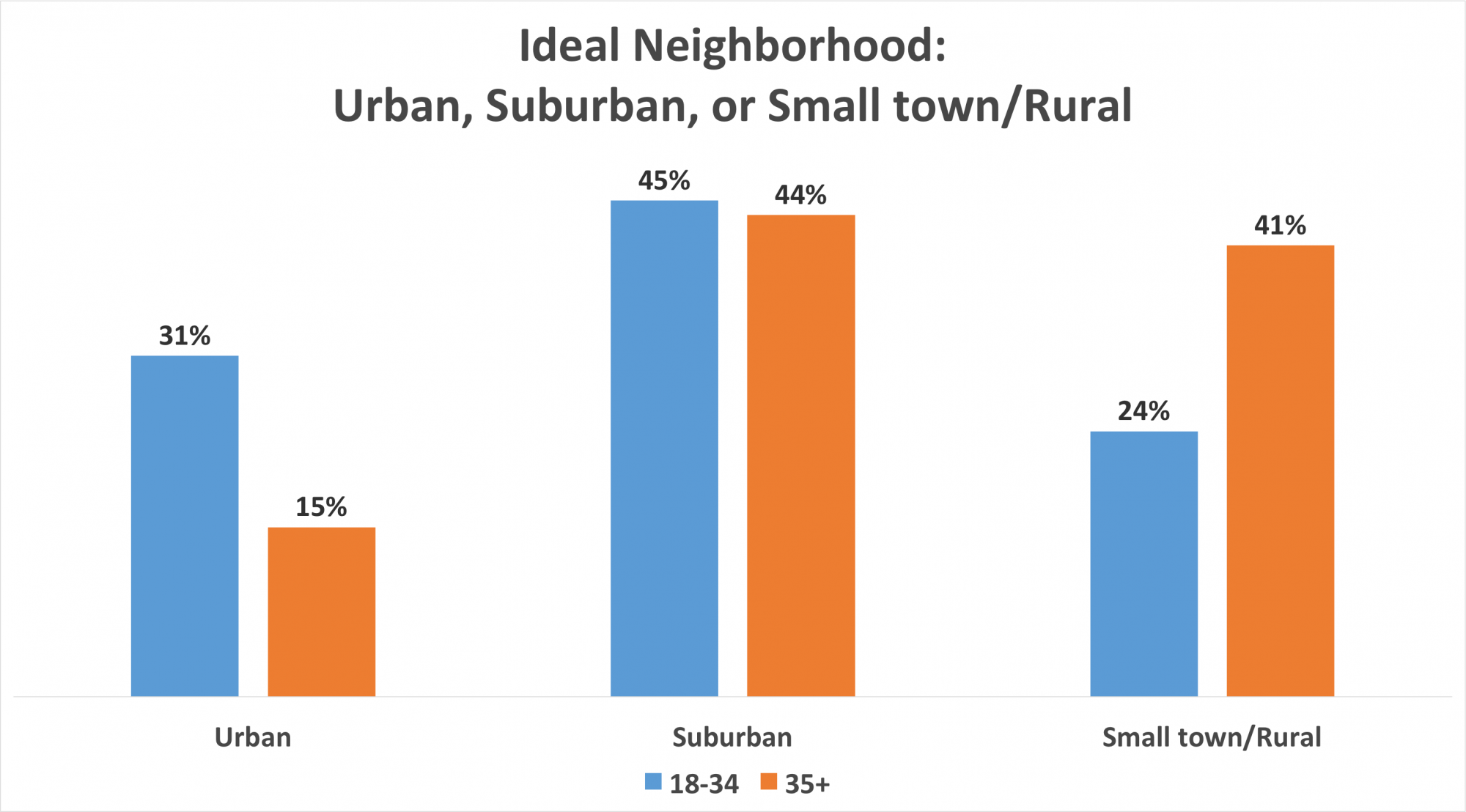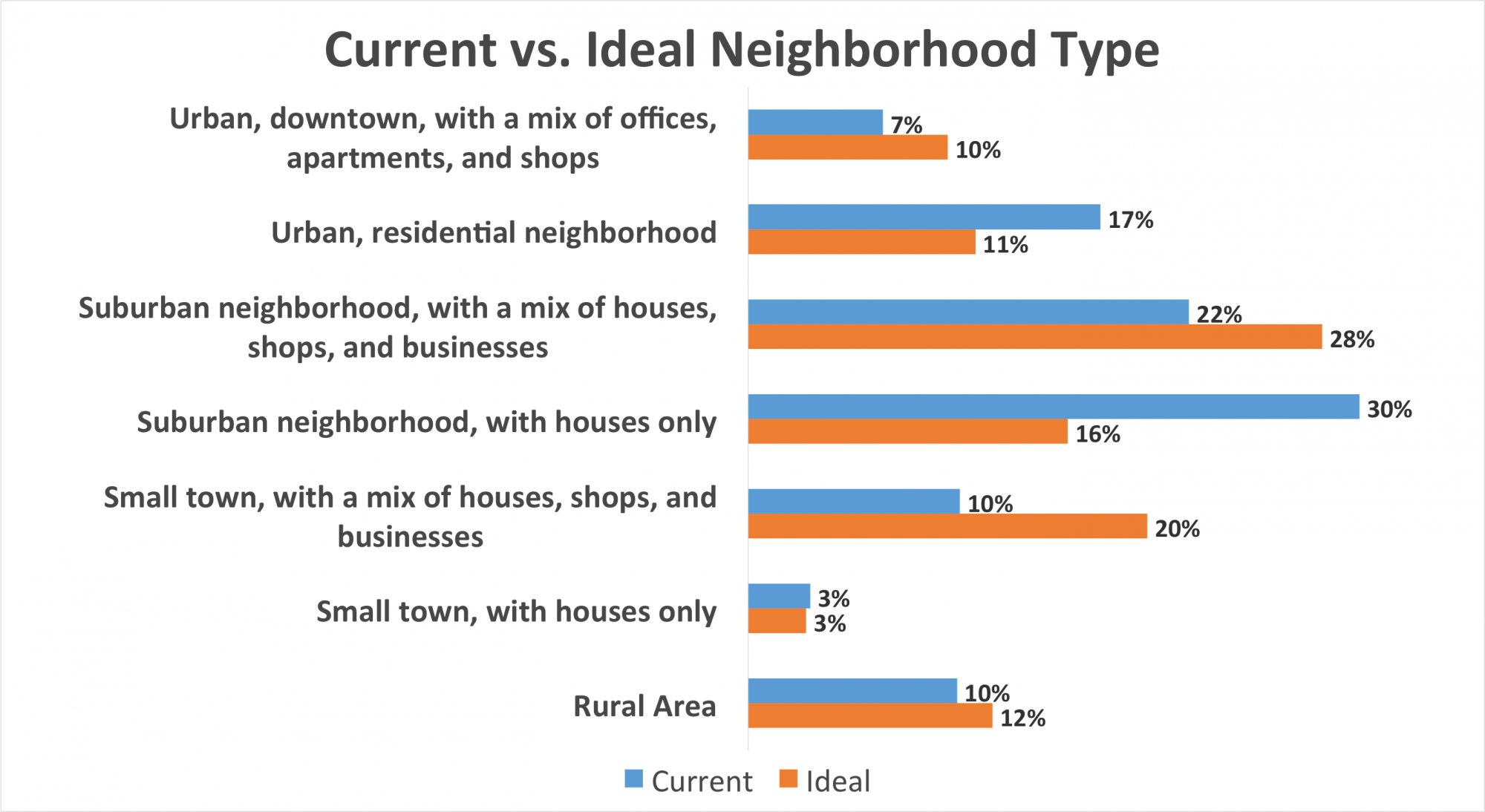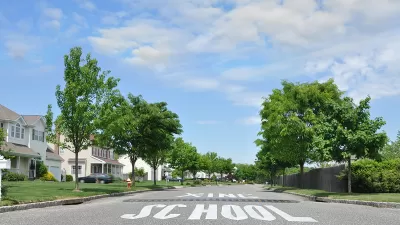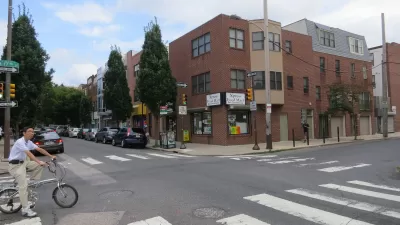The debate about whether Millennials prefer urban or suburban misses a big, important point: what Millennials really prefer is possible in either setting.

A tremendous amount of thought (and money) goes into understanding the housing and transportation preferences of millennials. As it turns out, most young Americans want what people of all ages want. And, like everyone else, they're not getting it.
Let's look at a fact that, on the surface, is very disheartening to a city lover like myself: Young people are more likely to move from the city to the suburbs than vice versa. This is from a Ben Casselman article published last year:
According to U.S. Census Bureau data released this week, 529,000 Americans ages 25 to 29 moved from cities out to the suburbs in 2014; only 426,000 moved in the other direction. Among younger millennials, those in their early 20s, the trend was even starker: 721,000 moved out of the city, compared with 554,000 who moved in.1 Somewhat more people in both age groups currently live in the suburbs than in the city
Indeed, for all the talk of the rebirth of American cities, the draw of the suburbs remains powerful. Across all ages, races, incomes and education groups, more Americans are still moving out of cities than in. (Urban populations are still growing, but because of births and immigration, not internal migration.)
Some of the exodus to the suburbs has to do with economics. The cost of housing in cities is high and rising, outpacing housing costs in suburbs. But that leads us to another fact that's even more painful for city lovers: Most millennials say they would prefer to live in the suburbs.
Many national surveys have observed the preference for suburbs among millennials. Among them is one that my firm (RSG) and TransitCenter conducted in 2013. We surveyed nearly 12,000 Americans living in or near cities (as most Americans do) and asked them what their ideal neighborhood type would be. Respondents could choose between seven options:
- Urban downtown, with a mix of offices, apartments, and shops
- Urban, residential neighborhood
- Suburban neighborhood, with a mix of houses, shops, and businesses
- Suburban neighborhood, with houses only
- Small town, with a mix of houses, shops, and businesses
- Small town, with houses only
- Rural area
Let's call 1 and 2 the ''urban" options, 3 and 4 the "suburban" options, and 5-7 the "small town/rural" options. Based on those groupings, the chart below shows the neighborhood types that respondents identified as their ideal.

The younger cohort shows more interest in living in urban areas, but the majority still prefers the suburbs. More importantly, there's no evidence here (or really anywhere else) to show that younger respondents' preferences won't change to the suburbs as they age.
Planners and policymakers might be tempted to conclude that most people, young and old alike, want large lots in leafy suburbs. But there's an important element of this preference that's missing, and it's rooted in this question: what is a suburb, anyway?
Not all suburbs are the same, and the definition is at best loose, even in our own survey. What is much more clear in our survey is the idea of mixing different types of land uses ("…houses, shops and businesses") together. Let's see what happens when we categorize the neighborhood types in a different way. Let's call 1, 3, and 5 the "mixed use" options, and 2, 4, 6, and 7 the "residential" options.

When we think of neighborhoods as "mixed use" and "residential" instead of "urban" and "suburban," a very different picture emerges across both age categories, and mixed use clearly wins out. So it's true that people prefer neighborhoods they describe as suburban, but they also want access to amenities that many suburbs do not offer.
Let's look at one last chart. This one shows the type of neighborhoods people of all ages currently live in alongside their ideal neighborhood type.

The takeaway here is that most people live in residential-only neighborhoods, but that's not where they'd like to live. The survey reveals a clear preference for mixed-use neighborhoods, regardless of the setting (urban, suburban, or small town). Millennials are no exception to this. A recent study from the Urban Land Institute found that "millennials represent a strong driver of demand for compact, mixed use development formats, in suburban or other locations." According to that report, most millennials desire single-family homes, though most also say they would like to live somewhere where they rarely need a car. Neither high-rises nor picket fences will do.
It's still unclear exactly what people have in mind when they are asked about a "suburban" or "small town" environment, and as survey researchers we can do better. What is already clear, however, is that wanting a coffee shop on your corner doesn't necessarily mean you want to live in Manhattan or San Francisco. Places like Burlington, Vermont and Silver Spring, Maryland fit the bill as communities that are hardly "urban," but confer the benefits of mixed-use living.
Understanding the preferences of millennials is important. There are a lot of them (70-80 million), and because they are, by definition young, they're likely to be around for a while. But the bottom line is that most Americans are not living in the type of neighborhoods they really like now. Planners needn't obsess about the future desires of young Americans. Instead, they can simply focus on how to provide the pleasant, walkable neighborhoods that people of all ages want to live in.
Ben Cummins is planner and survey researcher living in Washington, D.C. He holds a Master's in Planning from the Department of City and Regional Planning at Cornell.

Manufactured Crisis: Losing the Nation’s Largest Source of Unsubsidized Affordable Housing
Manufactured housing communities have long been an affordable housing option for millions of people living in the U.S., but that affordability is disappearing rapidly. How did we get here?

Americans May Be Stuck — But Why?
Americans are moving a lot less than they once did, and that is a problem. While Yoni Applebaum, in his highly-publicized article Stuck, gets the reasons badly wrong, it's still important to ask: why are we moving so much less than before?

Using Old Oil and Gas Wells for Green Energy Storage
Penn State researchers have found that repurposing abandoned oil and gas wells for geothermal-assisted compressed-air energy storage can boost efficiency, reduce environmental risks, and support clean energy and job transitions.

Greening Oakland’s School Grounds
With help from community partners like the Trust for Public Land, Oakland Unified School District is turning barren, asphalt-covered schoolyards into vibrant, green spaces that support outdoor learning, play, and student well-being.

California Governor Suspends CEQA Reviews for Utilities in Fire Areas
Utility restoration efforts in areas affected by the January wildfires in Los Angeles will be exempt from environmental regulations to speed up the rebuilding of essential infrastructure.

Native American Communities Prepare to Lead on Environmental Stewardship
In the face of federal threats to public lands and conservation efforts, indigenous groups continue to model nature-centered conservation efforts.
Urban Design for Planners 1: Software Tools
This six-course series explores essential urban design concepts using open source software and equips planners with the tools they need to participate fully in the urban design process.
Planning for Universal Design
Learn the tools for implementing Universal Design in planning regulations.
Heyer Gruel & Associates PA
City of Moreno Valley
Institute for Housing and Urban Development Studies (IHS)
City of Grandview
Harvard GSD Executive Education
Salt Lake City
NYU Wagner Graduate School of Public Service
City of Cambridge, Maryland





























